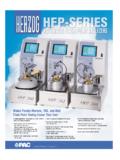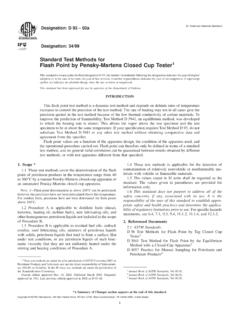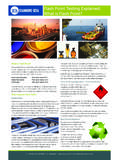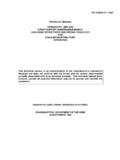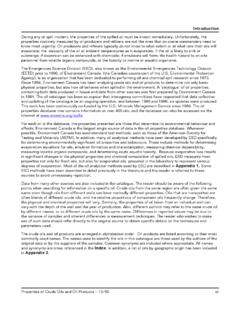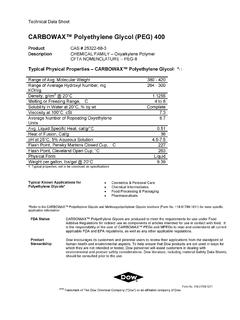Transcription of A Common Sense Approach to Hazardous Area - BATH GROUP
1 A Common Sense Approach to Hazardous area Classification for Electronic Instrumentation Jim Johnston Sr. Instrument/Electrical Engineer Bath Engineering Corporation 5656 South Staples Suite #110. Corpus Christi, Texas 78411. KEYWORDS. All keywords are identified in the body of this paper by italicized print. ABSTRACT. This paper is intended to present a practical and Common Sense Approach to determining the proper Hazardous area classification of a manufacturing or process facility. Industrial processes involving flammable or combustible materials may produce explosive atmospheres.
2 The concept of assessing and limiting the risk associated with the installation of electrical devices in areas where potentially explosive atmospheres may be present is referred to as area Classification . Many people take a by the books . Approach to area classification assessment. Unfortunately, this method almost always increases cost and sometimes compromises safety. This paper seeks to define a well-understood Common Sense Approach to area classification so that industrial owners and managers can reduce risk while mitigating capital waste.
3 INTRODUCTION. There are several entities that provide information regarding Hazardous area classification assessment. The ISA, NFPA, OSHA, and API are a few of the more familiar. The concept of Hazardous area classification assessment and the application of various recommended practices from the aforementioned entities are often mis-understood, confusing, and therefore mis-applied. This often results in a very conservative area classification assessment. Areas are classified as Division 1 when the location should have been classified as Division 2 and likewise, areas classified as Division 2 should have been classified as non- Hazardous .
4 To establish the framework for the Common Sense Approach to Hazardous area classification assessment, you must first have a basic understanding of its key definitions and develop an assessment methodology that is well understood by all that are involved in the assessment study. It should be the Common goal of all involved parties in the assessment study to strive to achieve a classification assessment that defines an acceptable level of safety commensurate with an acceptable level of risk that results in the reduction of the cost of electrical installations.
5 This paper is divided into four basic parts: Part 1 provides insight into the definition of several key terms that are associated with area classification assessment, Part 2 provides discussion regarding the development of an assessment methodology, Part 3 describes how the area classification assessment is conducted, and Part 4 shows how to develop hazard reduction methods to comply with the classified area . No mention is made of the zone concept in this report. (PART 1) THE DEFINITION OF KEY TERMS. An understanding of key definition of terms is required in order to establish the foundation for assessing the classification of an area .
6 Several of these definitions are taken directly word for word from the publications that are listed in the reference section. Paraphrasing is done to assist in the understanding of the intent of the definition. What is Hazardous area classification assessment ? Hazardous area classification assessment is a probability analysis and risk assessment evaluation of a manufacturing or process area processing a potentially flammable atmosphere that focuses exclusively on the minimization or elimination of electrical energy as a potential source of ignition.
7 To fully understand what is meant by the definition above, it is also important to understand what area classification is NOT. Hazardous area classification is NOT intended to be a secondary line of defense against: Poor process design Includes such issues as poor elastomer compatibility causing excessive emissions from valve packing, pump seals, and/or pipe flanges. Poor facility and equipment maintenance This often occurs when PM programs are poorly managed or not properly implemented. Faulty equipment operation This is an issue when apiece of equipment is a routine source of frequent leaks and is often caused by mis-application.
8 Catastrophic vapor releases This scenario occurs when a vessel is breached by some other means and the corresponding vapor release is uncontrollable and instantaneous. Often these types of releases are quite large in vapor mass and energy and will often find sources of ignition other than those associated with the normal operation of electrical equipment static charges, open flames, or hot surfaces. (Figure 1 shown below illustrates the expansive nature of a catastrophic release of hydrogen from a closed containment system.)
9 Dispersion model derived from PHAST. PHAST is dispersion modeling software licensed through Det Norske Veritas Risk Management Software Division). FIGURE 1 CATASTROPHIC H2 RELEASE. What are Hazardous area Classes ? Hazardous Areas are divided into three distinct classes that are totally dependent on the type of material that is encountered in the process. They are described as follows: Class I Areas These are locations in which flammable gases and/or vapors are or may be present in the air in quantities sufficient to produce an explosion or ignitable mixture.
10 In Class I Areas that utilize the division concept methodology there are two distinct divisions that are predicated on the operational interpretation of the words normal vs. abnormal and frequent vs. infrequent. The formal definitions are described as follows: Division 1 - These are locations in which ignitable concentrations of flammable gases or vapors can exist: under normal operating conditions. frequently because of maintenance or repair. because of frequent leakage. below grade where adequate ventilation does not exist.
